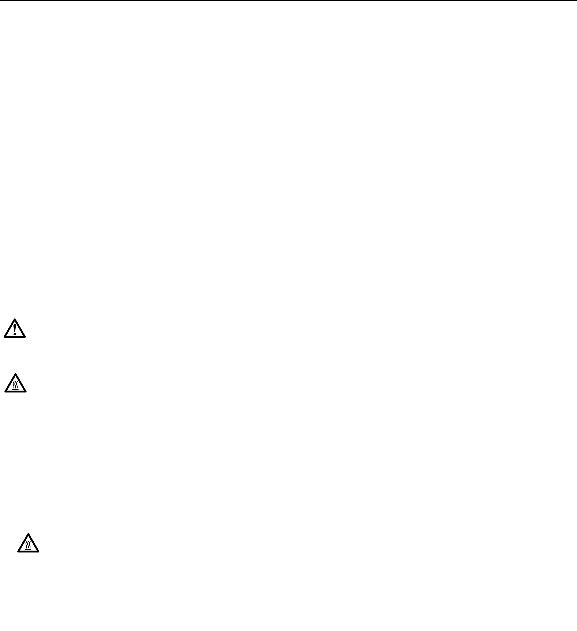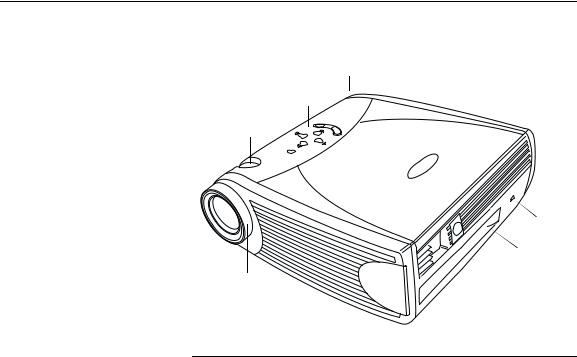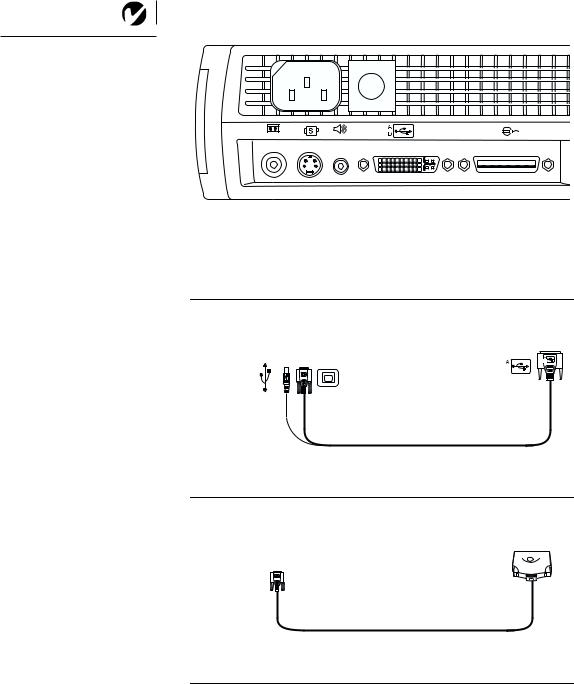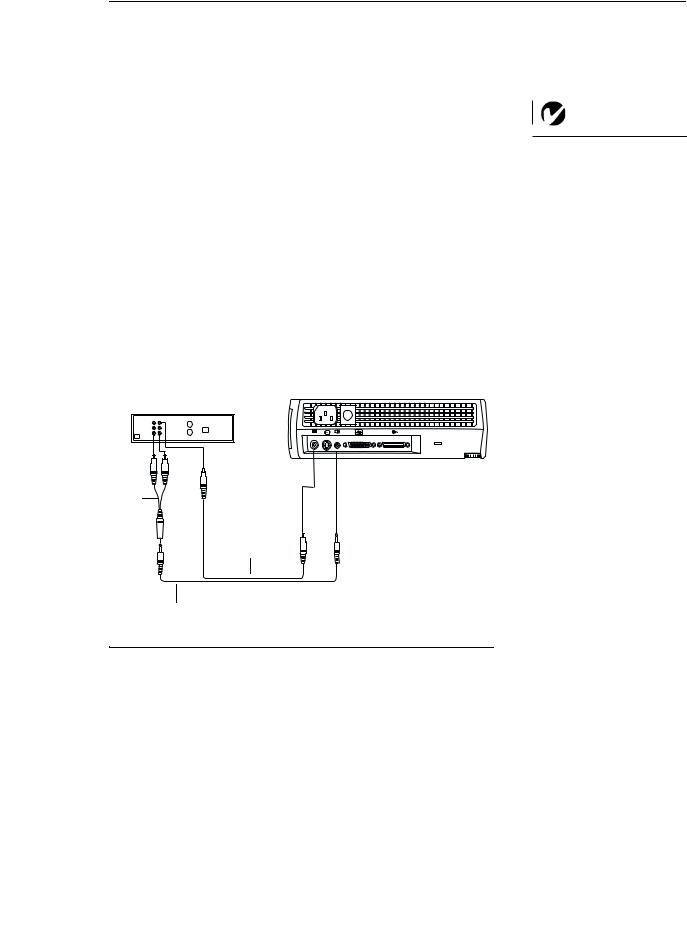Toshiba TDP-T1, TDP-S2 Manual

TABLE OF CONTENTS |
|
Safety Instructions |
iii |
Introduction |
1 |
Image Resolution |
1 |
Compatibility |
2 |
Unpacking the Projector |
2 |
Usage Guidelines |
4 |
If You Need Assistance |
5 |
Setting up the Projector |
7 |
Connecting a Computer |
9 |
Connecting a Video Player |
11 |
Powering up the Projector and Adjusting the Image |
13 |
Turning Off the Projector |
14 |
Using the Projector |
15 |
Basic Image Adjustment |
15 |
Using the Remote Control |
15 |
Adjusting the Projector |
17 |
Using the Keypad and Remote Buttons |
18 |
Using the On-Screen Menus |
20 |
Display Menu |
21 |
Audio Menu |
23 |
Image Menu |
24 |
Controls Menu |
27 |
Language Menu |
29 |
Status Menu |
30 |
Maintenance & Troubleshooting |
33 |
Cleaning the Lens |
33 |
Replacing the Projection Lamp |
33 |
Replacing the Batteries in the Remote Control |
36 |
Using the Security Lock |
36 |
Troubleshooting |
37 |
i
T a b l e |
o f |
C o n t e n t s |
|
|
|
Appendix |
41 |
Specifications |
41 |
Accessories |
42 |
Portable and Laptop Activation Chart |
43 |
Using Video Mirroring with a PowerBook Computer |
48 |
Projected Image Size |
49 |
Index |
51 |
ii

SAFETY INSTRUCTIONS
Please read and follow all safety instructions provided BEFORE using your new projector. Failure to comply with safety instructions may result in fire, electrical shock, or personal injury and may damage or impair protection provided by equipment. Please save all safety instructions.
Safety Definitions:
•Warning: Statements identify conditions or practices that could result in personal injury.
•Caution: Statements identify conditions or practices that could result in damage to your equipment.
Safety Symbols:
Attention: For information about usage of a feature, please refer to the User’s Guide.
Warning: Hot surface. Do not touch.
An arrow pointing to the lamp door on the projector.
Safety Terms:
•Warning: Don’t look directly into the lens when the lamp is turned on.
•Warning: To replace the lamp, turn the projector off by unplugging the power cord. To avoid burns, wait 30
minutes before opening the lamp door. Follow all instructions provided in this User’s Guide.
•Warning: Please use the power cord provided. Connect the power cord to a receptacle with a protective safety
(earth) ground terminal.
•Warning: Refer all service to qualified service personnel. Servicing your own projector will void the warranty. See the following page for the customer service contact information.
•Caution: Don’t block ventilation openings.
iii

S a f e t y |
I n s t r u c t i o n s |
|
|
•Caution: Don’t set liquids on the projector. Spilled liquids may damage your projector.
•Caution: Don’t place the projector on a hot surface or in direct sunlight.
•Caution: Do not drop the projector. Transport the projector in a vendor-approved case; refer to your Toshiba dealer or projectors.toshiba.com for more information.
Important Operating Considerations
Do not place the projector on a tablecloth or other soft covering that may block the vents. In the unlikely event of the bulb rupturing, thoroughly clean the area behind the projector and discard any edible items placed in that area.
|
|
|
) |
|
|
m |
|
|
.6 |
|
|
( |
|
|
|
ft |
|
|
|
2 |
|
|
|
 Do not place objects in
Do not place objects in
this area behind the projector
Customer Service
Please contact your Toshiba dealer for details.
iv

INTRODUCTION
The Toshiba TDP-S2 and TDP-T1 multimedia projectors are specifically designed for multipurpose use. They generate crisp, clear images using Digital Light Processing™ (DLP) technology, and feature an M1-DA connector for easy, built-in digital/analog and USB connectivity. They are easy to connect, easy to use, easy to transport, and easy to maintain. The TDP-S2 has native SVGA 800x600 resolution, the TDP-T1 has XGA 1024x768 resolution. The user interfaces of the two products are identical; information in this user’s guide applies to both products.
Image Resolution
TDP-S2
The SVGA resolution of the TDP-S2’s projected image is 800x600. The projector cannot compress screen resolutions above 1024x768. If your computer’s screen resolution is higher than 1024x768, reset it to a lower resolution before you connect the projector.
TDP-T1
The XGA resolution of the TDP-T1’s projected image is 1024x768. The projector cannot compress screen resolutions above 1024x768. If your computer’s screen resolution is higher than 1024x768, reset it to a lower resolution before you connect the projector.
NOTE: The TDP-S2 automatically expands 640x480 images to 800x600. You can display these images at their native resolutions by turning off the Auto Resize feature. See “Resize” on page 24 for more information.
NOTE: The TDP-T1 automatically expands 640x480 and 800x600 images to 1024x768. You can display these images at their native resolutions by turning off the Auto Resize feature. See “Resize” on page 24 for more information.
1

I n t r o d u c t i o n
NOTE: The projector is compatible with 1080i and 720P HDTV formats.
Compatibility
The projector is compatible with a wide variety of computers and video devices, including:
•IBM-compatible computers, including laptops, up to 1024x768 resolution.
•Apple® Macintosh® and PowerBook® computers up to 1024x768 resolution.
•Most standard VCRs, DVD players, HDTV sources, camcorders and laser disc players.
Unpacking the Projector
The projector comes with the items shown in Figure 1. Check to make sure all are included. Contact your Toshiba dealer immediately if anything is missing.
If you are experienced in setting up presentation systems, use the Quick Start card that was included in the shipping box. For complete details on connecting and operating the projector, refer to this User’s Guide.
2

1 |
2 |
|
3
5 |
4 |
|
11 |
||
|
||
|
9 |
|
6 |
|
10 |
|
|
|
12 |
|
8 |
|
|
|
7 |
|
|
|
|
|
FIGURE 1 |
|
|
|
Shipping box contents |
1. |
TDP-S2 or TDP-T1 projec- |
7. |
PR Lite computer cable |
|
tor + lens cap |
|
|
2. |
Soft carry case |
8. |
Audio cable adapter |
3. |
User’s Guide, Quick Start |
9. |
Mac adapter |
|
card, and CD |
|
|
4. |
Power cord |
10. |
Composite video cable |
5. |
Remote control |
11. |
Audio cable |
6. |
M1-DA analog computer |
12. |
S-video cable |
|
cable |
|
|
3

I n t r o d u c t i o n
speaker
keypad
zoom ring
Security lock
connector panel power
focus ring |
button |
power |
|
|
cord |
|
connector |
FIGURE 2
Side view of projector
Usage Guidelines
•Do not look directly into the projection lens when the lamp is turned on. The bright light may harm your eyes.
•Do not block the grills on the projector. Restricting the air flow can cause it to overheat and turn off. If this happens, you must wait a minute before attempting to turn it back on.
•Handle the projector as you would any product with glass components. Be especially careful not to drop it.
•Avoid leaving the projector in direct sunlight or extreme cold for extended periods of time. If this happens, allow it to reach room temperature before use.
•Transport the projector in a vendor-approved hard or soft case; refer to your Toshiba dealer or projectors.toshiba.com for more information.
4

If You Need Assistance
The first place to look for help is in this manual. Be sure to check the guidelines in “Troubleshooting” on page 37.
Please contact your Toshiba dealer for details.
5

I n t r o d u c t i o n
6

SETTING UP THE PROJECTOR
1Place the projector on a flat surface.
•The projector must be within 10 feet (3 m) of your power source and within 6 feet (1.8 m) of your computer.
•If you want to project from behind a translucent screen, set up the projector behind your screen. See “Rear Projection” on page 28 to reverse the image.
•If you are installing the projector on the ceiling, refer to the installation guide that comes with the Ceiling Mount Kit for more information. To turn the image upside down, see “Ceiling Projection” on page 27. The Ceiling Mount Kit is sold separately, contact your Toshiba dealer to order.
2Position the projector the desired distance from the screen.
•The distance from the lens of the projector to the screen and the zoom setting determine the size of the projected image. Figure 3 shows three projected image sizes. For more information about image size, see “Projected Image Size” on page 49.
|
1 |
|
0 |
|
f |
|
t |
|
. |
|
6 |
|
f |
2 |
t |
. |
|
. |
|
5 |
|
f |
|
t |
|
. |
|
5 ft. |
12 ft. |
20 ft. |
|
||
|
|
FIGURE 3
Projected image size at minimum zoom
3 Make sure the projector and the computer are turned off.
7

S e t t i n g |
u p |
t h e |
P r o j e c t o r |
|
|
|
|
NOTE: Before you continue, |
|
|
make sure the projector and all |
|
|
other equipment is turned off. If |
|
|
you’re connecting a computer, |
|
|
make sure the distance between it |
in |
in |
|
|
and the projector is 6 feet or less.
|
|
|
|
|
|
|
|
|
|
|
|
|
|
|
|
|
|
|
|
composite |
S-video |
|
M1-DA |
|
|
||||
|
PR Cable |
||||||||
video |
|
||||||||
|
|
Audio in |
data interface |
data interface |
|||||
|
|
|
|
||||||
FIGURE 4
Connector panel
to USB mouse |
to computer video |
to computer |
to projector |
FIGURE 5
M1-DA analog computer cable
|
|
to projector |
to computer |
||
FIGURE 6
PR Lite computer cable
8

Connecting a Computer
The projector ships with an M1-DA analog computer cable and a PR Lite computer cable. If your computer has a digital output, you can order the optional M1-DA digital computer cable. Contact your Toshiba dealer for ordering information.
1Plug the 
 end of the M1-DA analog computer cable into the
end of the M1-DA analog computer cable into the 
 connector on the projector.
connector on the projector.
2Plug the blue  end of the M1-DA analog computer cable into the video connector on your computer.
end of the M1-DA analog computer cable into the video connector on your computer.
Computer 1 |
|
|
Computer 2 |
|
|
in |
in |
|
|
|
audio cable |
|
|
|
USB |
M1-DA analog |
PR Lite |
||
mouse |
||||
computer cable |
computer cable |
|||
|
||||
FIGURE 7
Connecting the projector to a computer
NOTE: Many laptop computers do not automatically turn on their external video port when a secondary display device such as a projector is connected. Refer to your computer manual for the command that activates the external video port. Activation commands for some laptop computers are listed in the Appendix of this manual on page 43 or visit support.toshiba.com for more information.
NOTE: If you are connecting an older Macintosh computer that does not have a 15-pin connector, you must use a Mac adaptor between the computer and the projector. The supplied Mac adapter will only work with the 1024x768 resolution. Please set your Mac’s video card accordingly.
9

S e t t i n g |
u p |
t h e |
P r o j e c t o r |
|
|
|
|
NOTE: The USB mouse is supported for use with Windows 98, Windows 2000, and Apple OS 8.5 and higher only.
NOTE: You do not need to restart your computer after connecting a USB mouse to use it (it is hotpluggable).
Do you want to control the computer’s mouse from the projector’s remote or keypad?
1Plug the 
 end of the M1-DA analog computer cable into the USB mouse connector on your computer. If your computer has a PS/2 mouse connector and not a USB mouse connector, you can purchase the optional PR Cable3 which has a PS/2 mouse connector or the Executive Remote IR Receiver. Contact your Toshiba dealer to order.
end of the M1-DA analog computer cable into the USB mouse connector on your computer. If your computer has a PS/2 mouse connector and not a USB mouse connector, you can purchase the optional PR Cable3 which has a PS/2 mouse connector or the Executive Remote IR Receiver. Contact your Toshiba dealer to order.
Do you want to play your computer’s audio on the projector?
1Plug either end of the audio cable into the audio connector on your computer. Only one PC audio input is available.
2Plug the other end of the audio cable into the  connector on the projector.
connector on the projector.
Now you’re ready to power up the projector and your laptop. Skip to “Powering up the Projector and Adjusting the Image” on page 13.
10

Connecting a Video Player
1If your video player uses a round, one-prong composite video connector, you’ll need only the audio cable, audio adapter, and composite video cable that shipped with the projector.
•If your video player uses a round, four-prong S-video connector, you’ll need the S-video cable in addition to the audio cable and audio adapter.
2Plug the composite video cable’s yellow connector into the “video-out” connector on your video player (Figure 8). This connector may be labeled “To Monitor.”
•If you’re using an S-video cable, connect it to the “S-video out” connector on the video player (Figure 9).
3Plug the other yellow connector into the composite video connector 


 on the projector.
on the projector.
•If you’re using S-video, plug the other end of the cable into
the “S-video” connector  on the projector (Figure 9).
on the projector (Figure 9).
in |
in |
audio adapter
composite video cable
audio cable
FIGURE 8
Connecting the projector to a video player using the standard video cable (with composite video connector) and the audio cable and adapter
NOTE: HDTV sources must be connected to the projector using the M1-DA computer cable (not a composite or S-video cable).
11

S e t t i n g |
u p |
t h e |
P r o j e c t o r |
|||||
|
|
|
|
|
|
|
|
|
|
|
|
|
|
|
|
|
|
|
|
|
|
|
|
|
|
|
|
|
|
|
|
|
|
|
|
|
|
|
|
|
|
|
|
|
|
|
|
|
|
|
|
|
|
in |
in |
NOTE: The audio adapter is provided so that the same audio cable used to connect a computer can be used with the adapter to connect a VCR.
CAUTION: Your video player may also have a “Video Out” connector for a coaxial cable connection. DO NOT use this to connect to the projector.
audio |
S-video |
|
adapter |
||
cable |
||
|
audio cable
FIGURE 9
Connecting the projector to a video player using an S-video cable and the audio cable and adapter
4Plug the audio adapter’s white connector into the left “audio out” connector on your video player. Plug the adapter’s red connector into the right “audio out” connector on the video player (Figure 8 and Figure 9).
5Plug the audio adapter’s other end into the audio cable.
6Plug the audio cable into the “audio in”  connector on the projector.
connector on the projector.
The projector is compatible with these major broadcast video standards: NTSC, NTSC 4.43, PAL, PAL-M, PAL-N, PAL-60, and SECAM. It automatically adjusts to optimize its performance for the incoming video.
12

Powering up the Projector and Adjusting the Image
1Remove the lens cap.
2Plug the power cord into the side of the projector, then plug it into your electrical outlet. A surge-protected power strip is recommended.
3Press the Power button on the side of the projector.
•The fans start to run, the LED on the top of the projector (Figure 13 on page 18) lights green, and the startup screen appears. It takes about one minute for the image to achieve full brightness.
4If you connected a video player, turn it on.
•The video image should display on the projection screen. If a computer source is active, press the source button on the keypad (page 18) or the video button on the remote to display your video image. You can select a default source to determine which source the projector examines first during power-up for active video; see “Default Source” on page 28.
•Use the volume buttons to adjust the volume.
5Turn on your computer.
•The computer image should display on the projection screen. If a video source is active, press the source button on the keypad or the computer button on the remote to display your computer’s image. Make sure your laptop’s external video port is activated; see “Portable and Laptop Activation Chart” on page 43 for details.
•If necessary, make adjustments to the image using the projector’s on-screen menus. To open the menus, press the menu button on the keypad or remote, then select the Display or Image menu. For more information about the menus, see page 20.
NOTE: Always use the power cord that shipped with the projector.
NOTE: The first time you connect your computer to the projector, the computer may display a message stating that new hardware was found. The Add New Hardware Wizard may appear. Use the Wizard to load the correct driver (the computer considers the projector a Plug and Play Monitor).
NOTE: With some computers, the order in which you power up the equipment is very important. Most computers should be turned on last, after all other peripherals have been turned on. Refer to your computer’s documentation to determine the correct order.
13

S e t t i n g |
u p |
t h e |
P r o j e c t o r |
|
|
|
|
NOTE: To maximize lamp life, allow the projector to run for at least five minutes before turning it off.
Turning Off the Projector
If you want to turn off the projector for a short period of time, press the standby button on the keypad or remote. This blanks the screen for fifteen minutes, but keeps the projector running. (You can change the amount of time the projector stays in standby mode; see “Standby Time” on page 27 for details.) After 15 minutes, the lamp goes out (the projector keeps running). To exit standby mode, press the standby button again. (It may take several seconds for the projection lamp to reach full power and project the image again.)
To completely power off the projector, press the Power button. If you want to turn the lamp back on immediately, you must allow about a minute for the lamp to cool. The lamp won’t light if it’s too hot.
14

USING THE PROJECTOR
This section describes how to use and make adjustments to the projector. It also provides a reference to the keypad and remote buttons and the options available from the on-screen menus.
Basic Image Adjustment
1Make sure you have powered up your equipment in the right order (page 13).
2If the image doesn’t display completely, zoom the image (page 17), adjust the height of the projector (page 17) or center the image by adjusting its horizontal or vertical position (page 26). Be sure the projector is at a 90 degree angle to the screen.
3If the image is out of focus, rotate the focus lens (page 17).
4If the image appears to shimmer or if it has blurry vertical bars after you have adjusted the focus, turn Auto Image (page 24) off and then back on to reset the automatic sync and tracking. If that doesn’t clear up the image, turn Auto Image off and adjust the sync (page 25) and/or the tracking
(page 25) manually.
5If the colors don’t look right, adjust the brightness (page 21).
Using the Remote Control
To control the computer’s mouse from the projector’s remote or keypad, you must connect the USB mouse connector on the computer cable to the computer. See page 10 for details.
The projector ships with a remote that has four function buttons, a disk mouse and two mouse buttons, one on the top of the remote and one on the bottom.
Point the remote control at the projection screen or at the front of the projector (not at the computer). The range for optimum operation is about 25 feet. If you point the remote at the projection screen, the distance to the screen and back to the projector must be less than or equal to 25 feet. For best results, point the remote directly at the projector.
15
